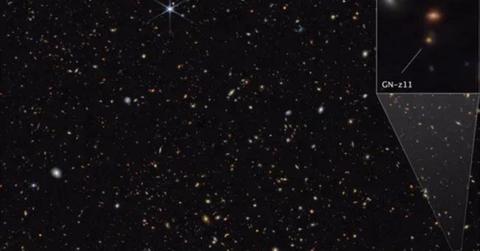Stellar Discovery: James Webb Telescope Detects Possibly Earliest Stars in the Known Universe

GN-z11 is found in the constellation of Ursa Major, in a region of sky being studied by the Great Observatories Origins Deep Survey (GOODS) project.
Recent revelations from observations conducted by the James Webb Space Telescope have brought to light compelling evidence for the existence of the universe's first generation of stars.
This groundbreaking evidence emerges from an in-depth examination of one of the most remote galaxies known to us.
Initially discovered by the Hubble Space Telescope in 2015, the galaxy, named GN-z11, stood as a benchmark for cosmic distance until the advent of the James Webb Space Telescope.
With a redshift of 10.6, the discussion around GN-z11 shifts from its mere distance to a reflection on its existence approximately 430 million years after the Big Bang.
To put those dates into perspective, considering the current age of the universe at 13.8 billion years, GN-z11 emerges as a crucial object of study, LiveScience reported.
The JWST, leveraging its advanced capabilities, has delved into GN-z11's mysteries, yielding profound insights into the early growth of galaxies.
In two groundbreaking papers, researchers unveil significant discoveries regarding GN-z11, shedding light on the mechanisms behind the formation and evolution of galaxies in the universe's infancy.
GN-z11 distinguishes itself as the most luminous galaxy known within its redshift range, challenging conventional models of galaxy formation.
Notably, the JWST continues to unveil similar high-redshift galaxies, often exceeding the brightness predicted by existing cosmological models.
Through meticulous observations utilizing the JWST's near-infrared instruments, led by Roberto Maiolino of the University of Cambridge, researchers have unearthed compelling evidence hinting at the presence of Population III stars — the universe's first stellar generation — within GN-z11.
Never miss a story — sign up for the Front Page Detectives newsletter. Be on the scene the moment news breaks.
These stars, theorized but never directly observed, are believed to have birthed from pristine hydrogen and helium, devoid of heavy elements. The discovery of ionized helium near the galaxy's periphery strongly suggests the presence of these ancient stars, emitting colossal amounts of ultraviolet radiation, further substantiating their existence.
Moreover, the research team uncovered evidence for a supermassive black hole, weighing approximately two million solar masses, residing at the heart of GN-z11.
Intense radiation emanating from the black hole's accretion disk, along with ionized chemical elements typical of such environments, underscores the galaxy's cosmic significance.
These findings, documented in journals such as Astronomy & Astrophysics and Nature, offer compelling insights into the early epochs of cosmic evolution.
By probing distant galaxies like GN-z11, astronomers deepen our understanding of the universe's formative stages, challenging existing paradigms while reaffirming the elegance of standard cosmology.
Become a Front Page Detective
Sign up to receive breaking
Front Page Detectives
news and exclusive investigations.
